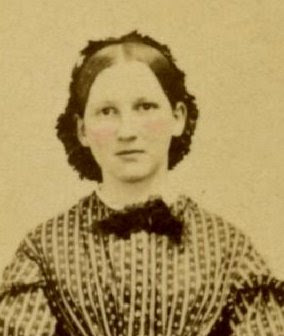Some heartbreaking events in history took place during the 1860's. In Britain, Queen Victoria suffered the death of both her mother and her husband, Prince Albert. Her public life was effectively over; she withdrew from the political spotlight (although she carried on her duties in private), and wore black for the rest of her life.
Meanwhile, in America, a presidential election was underway. Abraham Lincoln ran against John C. Beckinridge and won by a solid majority. A short time afterwards, the American Civil War began, turning the North and South against one another. The war finally ended in 1865, only a few weeks after President Lincoln was shot and killed by John Wilkes Booth.
After the frolicking fun of the previous decade, the 1860's were a sobering dose of reality. This is reflected in the slightly plainer clothes of the era. It seems like whenever there's a major war, the economy and other factors of wartime life influence the clothing to be plainer and more built for work. We'll see this again during the end of the Edwardian Era with World War I, and again in the 40's during World War II.
At the beginning of the 1860's, sleeves were wide near the bottom as they were in the previous decade. As the decade progressed, narrow sleeves also became popular, and both kinds of sleeves were seen commonly for day wear. Short, fitted sleeves remained par for the course in the evening.
One thing I'm noticing about the bodices is that we've lost the v-shaped panels of fabric iconic of the 1850's. Instead, bodices are square and structured, with buttons down the front. Several gowns for both day and evening were two-piece. According to Wikipedia,
"A skirt might be made with two bodices, one long-sleeved and high neck for afternoon wear and one short-sleeved and low-necked for evening."
It appears as though bodices and skirts were sometimes mixed and matched.
Skirts changed slightly in the early-mid decade. Instead of having volume
everywhere like in the previous decade, the bulk drifted to the back of the skirt, and slight trains came into fashion.
The fullness in the back of the skirt paired with the straight, natural a-line of the front to me looks like a forerunner for the early bustles that we'll see in the 1870's. Some skirts in this decade even look like they're supported by bustle pillows.
Trims, although not as large or as fancy as in the 1850's, were still pretty popular for both day and evening.
 |
| Source. Looking at this dress and others that were made in the USA makes me think that silk, although still very popular, wasn't as overwhelmingly used in America as it was in Europe. |
Lace seems like it's declining in popularity (perhaps by necessity). Though it's still seen on some evening dresses, it's in much smaller quantities than in the 1850's.
Now, this is the fun part. Guess what I'm watching right now?
Gone With the Wind. Otherwise known as the perfect movie to watch while writing this post. It's my first time watching the film, and there are two things I really love about it: 1. The way Mammy tells it like it is, and 2. Scarlett's dresses. And no post about the 1860's would be complete without a (very) mini
Gone With the Wind costume analysis. Of course, I could be persuaded to do a proper one later. You never know. Here's a quick look at Scarlett's first two costumes in the film.
Scarlett's first costume is stuck in my mind. It's very late 1850's, with tiers and ruffles and a
massive hoop skirt. The bodice also foreshadows the mid 1860's with its buttons in the front. For some reason, though, the bodice does feel a little 1930's-40's to me. Maybe it's the red belt. Or the hair. Either way, I still love this puffy cloud of a dress.
The green and white gown that Scarlett wears to the picnic at Twelve Oaks is my family's pick for favorite costume in the film thus far (we're halfway through the epic 4-hour film). The ruffles-and-bows neckline is very accurate, as is the print. The pointed end to the bodice is another hallmark of the late 50's-early 60's, although I'm not 100% sure about the silk sash. The gauzy material isn't exactly period, but it is really pretty, and it moves beautifully.
Hair was worn parted down the middle, in low buns often involving braids and ringlets. In the evening, they were decorated with ribbons, flowers, and other fun doodads.
During the day, hair was often gathered into hairnets. Said hairnets were sometimes decorated with ribbons or small pearls.
When most people think "Victorian fashion," they think of bustles, tiny fascinators, button-up boots, and a plethora of things iconic of the last three decades of the 19th century. Next week, we'll see the beginning of that era. For now, because I can't bear to have a post without a painting by Franz Xaver Winterhalter, I'll leave you with one of his most famous works, a portrait of Empress Elisabeth of Austria painted during the 1860's.












No comments:
Post a Comment
,mmmmmmmmmmmmmmmmmmmmmmmmmmmmmmmmmmmmmmmmmmmmmmmmmmmmmmmmmmmmmmmmmmmmmmmmmmmmmmmmmmmmmmmmmmmmmmmmmmmmmmmmmmmmmmmmmmmmmmmm'aaaaaaaaaaaakAAAQA
I was going to type something clever, but my cat provided this triumph of literature. Thank you for commenting! Just keep it clean, on-topic, and respectful.